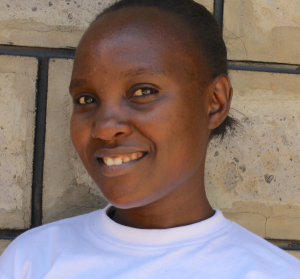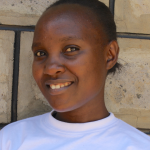Kaimosi Demonstration Secondary School does not have a reliable source of water on campus. Therefore, students must leave school in search of the water they need. Water demands at Kaiomsi Secondary are especially high because it has a dormitory where students live full time.
Students walk out past the school farm and to cross a busy road. They most often find their water at a spring in the community, which is especially crowded on the weekends. When we went there with them, we found the water trickling with very low pressure. It is clearly inadequate. In fact, we were already getting impatient because the students had many containers to fill up on our trip. It takes over 5 minutes to fill one 20-liter jerrycan.
The school kitchen has a tap attached to a water service, but the pressure there is extremely low. There are multiple times a week that the tap won't turn on at all. The tapped water in the school was installed by the county government, which is also responsible for paying the water bills. The government sometimes goes slack and the supply can be cut short for months. Sometimes, the staff gets so agitated that they walk out with the students to fill their containers at the spring, too.
There are 641 students, 31 teachers, and 21 support staff at this school. Most of the students and teachers have been treated for typhoid and amoeba. These cases start as stomach complaints which later turn out to be serious health conditions and they have to be rushed to the hospital for diagnosis.
Principal Patrick Amalemba lives on school grounds since it's a boarding school. "My stomach burns up whenever I drink water in school. It is very unfortunate that I stay in the school compound and I access the same water sources in my house," he said.
What we can do:
Training
The boys' latrines had an awful stench and we couldn't get past the first door to check the any of other pits. Most of them are worn out and need renovations. The girls' latrines were in a better condition and clean. The students do not practice handwashing after visiting the toilets.
"I just got a little bit worried when you raised the issue of handwashing. This has opened my eyes to the other cause of stomachache cases that are always reported to the nurse," said Principal Amalemba. The illness isn't only caused by drinking dirty water, but from germs spread around due to a lack of hygiene.
Training will be held for two days. The facilitator will use PHAST (participatory hygiene and sanitation transformation), ABCD (asset-based community development), CTC (child to child), lectures, group discussions, and handouts to teach health topics and ways to promote good practices within the school. The CTC method will prepare students to lead other students into healthy habits, as well as kickstart a CTC club for the school.
Handwashing Stations
This CTC club will oversee the new facilities, such as handwashing stations, and make sure they are kept clean and in working condition. The two handwashing stations will be delivered to the school, and the club will fill them with water on a daily basis and make sure there is always a cleaning agent such as soap or ash.
VIP Latrines
Two triple-door latrines will be constructed with local materials that the school will help gather. Three doors will serve the girls while the other three serve the boys. And with a new source of water on school grounds, students and staff should have enough to keep these new latrines clean.
Rainwater Catchment Tank
A 50,000-liter rainwater catchment tank will help alleviate the water crisis at this school. The school will also help gather the needed materials such as sand, rocks, and water for mixing cement. Once finished, this tank can begin catching rainfall that will be used by the school’s students and staff.
We and the school strongly believe that with this assistance, standards will significantly improve. These higher standards will translate to better health which will unlock the potential for higher academic achievement.

 Rainwater Catchment
Rainwater Catchment
 Rehabilitation Project
Rehabilitation Project



































